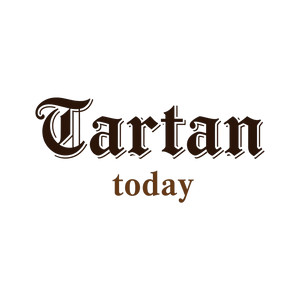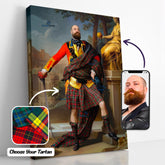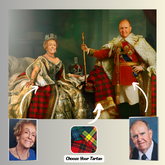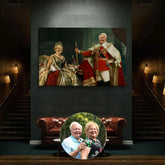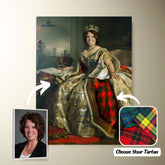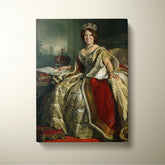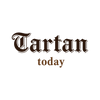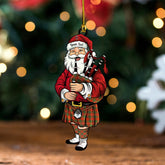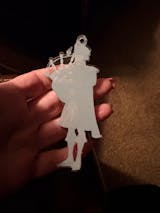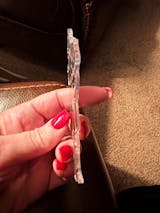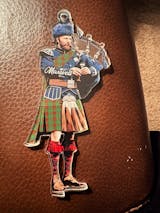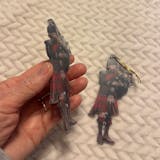-
Personalized Clan Bruce Modern Tartan Bagpipe Ornament with Custom Name – Scottish Christmas Tree Decoration DN63
Personalized Clan Bruce Modern Tartan Bagpipe Ornament with Custom Name – Scottish Christmas Tree Decoration DN63Celebrate your Scottish heritage with this unique wood & acrylic tartan ornament. Perfect as a personalized Christmas decoration or a meaningful gift for friends and relatives on special occasions...- From $19.99 USD
$25.99 USD- From $19.99 USD
- Unit price
- per
Save $6.00 -
Personalized Clan Bruce Ancient Tartan Bagpipe Ornament with Custom Name – Scottish Christmas Tree Decoration KF13
Personalized Clan Bruce Ancient Tartan Bagpipe Ornament with Custom Name – Scottish Christmas Tree Decoration KF13Celebrate your Scottish heritage with this unique wood & acrylic tartan ornament. Perfect as a personalized Christmas decoration or a meaningful gift for friends and relatives on special occasions...- From $19.99 USD
$25.99 USD- From $19.99 USD
- Unit price
- per
Save $6.00 -
Personalized Clan Bruce Ancient Clan Crest Tartan Santa Ornament – Custom Acrylic Christmas Decoration LE14 - Bruce
Personalized Clan Bruce Ancient Clan Badge Tartan Ornament – Custom Acrylic Christmas Decoration LE14Celebrate your Scottish heritage with this unique wood & acrylic tartan ornament. Perfect as a personalized Christmas decoration or a meaningful gift for friends and relatives on special occasions such as...- From $19.99 USD
- From $19.99 USD
- Unit price
- per
-
Bruce
-
Clan Bruce Family Tartan 2D T-shirt OT77 - Black
Bruce Family Tartan Clan 2D T-shirt OT77 Product detail: This new 2D t-shirt features a relaxed fit for Men and Women, durable, breathable and soft Made from 100% cotton The High-resolution graphic artwork is printed on the entire shirt. Machine wash cold. The print...- $29.25 USD
- $29.25 USD
- Unit price
- per
-
Black
-
White
-
Navy
-
Storm Grey
-
Clan Bruce Modern Tartan Crest Heart Ceramic Ornament RS24 - Bruce Modern Tartan
Clan Bruce Modern Tartan Crest Heart Ceramic Ornament RS24 One of the best things about Christmas is that it gives you an excuse to dress up your home with all of the lovely ornaments we associate with the holiday season. With so many different...- From $19.25 USD
- From $19.25 USD
- Unit price
- per
-
Bruce Modern Tartan
-
Clan Bruce Ancient Tartan Crest Round Ceramic Ornament FR91 - Bruce Ancient Tartan
Clan Bruce Ancient Tartan Crest Round Ceramic Ornament FR91 One of the best things about Christmas is that it gives you an excuse to dress up your home with all of the lovely ornaments we associate with the holiday season. With so many different...- From $19.25 USD
- From $19.25 USD
- Unit price
- per
-
Bruce Ancient Tartan
-
Clan Bruce Modern Tartan Crest Christmas Santa Hat SW26 - Bruce Modern Tartan
Clan Bruce Modern Tartan Crest Christmas Santa Hat SW26 Product Detail: Material: Polyester Design Area: Single side full width printing Sizes:'S (26 x 38 cm); L (32.5 x 45 cm)- From $25.41 USD
- From $25.41 USD
- Unit price
- per
-
Bruce Modern Tartan
-
Personalized Clan Bruce Modern Tartan Drummer Ornament with Custom Name – Scottish Christmas Tree Decoration RM39
Personalized Clan Bruce Modern Tartan Drummer Ornament with Custom Name – Scottish Christmas Tree Decoration RM39Celebrate your Scottish heritage with this unique wood & acrylic tartan ornament. Perfect as a personalized Christmas decoration or a meaningful gift for friends and relatives on special occasions...- From $19.99 USD
$25.99 USD- From $19.99 USD
- Unit price
- per
Save $6.00 -
Personalized Clan Bruce Ancient Tartan Drummer Ornament with Custom Name – Scottish Christmas Tree Decoration SF97
Personalized Clan Bruce Ancient Tartan Drummer Ornament with Custom Name – Scottish Christmas Tree Decoration SF97Celebrate your Scottish heritage with this unique wood & acrylic tartan ornament. Perfect as a personalized Christmas decoration or a meaningful gift for friends and relatives on special occasions...- From $19.99 USD
$25.99 USD- From $19.99 USD
- Unit price
- per
Save $6.00 -
Personalized Clan Bruce Weathered Tartan Bagpipe Ornament with Custom Name – Scottish Christmas Tree Decoration AM35
Personalized Clan Bruce Weathered Tartan Bagpipe Ornament with Custom Name – Scottish Christmas Tree Decoration AM35Celebrate your Scottish heritage with this unique wood & acrylic tartan ornament. Perfect as a personalized Christmas decoration or a meaningful gift for friends and relatives on special occasions...- From $19.99 USD
$25.99 USD- From $19.99 USD
- Unit price
- per
Save $6.00 -
Personalized Clan Bruce Reproduction Tartan Bagpipe Ornament with Custom Name – Scottish Christmas Tree Decoration JN76
Personalized Clan Bruce Reproduction Tartan Bagpipe Ornament with Custom Name – Scottish Christmas Tree Decoration JN76Celebrate your Scottish heritage with this unique wood & acrylic tartan ornament. Perfect as a personalized Christmas decoration or a meaningful gift for friends and relatives on special occasions...- From $19.99 USD
$25.99 USD- From $19.99 USD
- Unit price
- per
Save $6.00 -
Personalized Clan Bruce Old Reproduction Tartan Bagpipe Ornament with Custom Name – Scottish Christmas Tree Decoration RR41
Personalized Clan Bruce Old Reproduction Tartan Bagpipe Ornament with Custom Name – Scottish Christmas Tree Decoration RR41Celebrate your Scottish heritage with this unique wood & acrylic tartan ornament. Perfect as a personalized Christmas decoration or a meaningful gift for friends and relatives on special...- From $19.99 USD
$25.99 USD- From $19.99 USD
- Unit price
- per
Save $6.00 -
Personalized Clan Bruce Old Ancient Tartan Bagpipe Ornament with Custom Name – Scottish Christmas Tree Decoration XL14
Personalized Clan Bruce Old Ancient Tartan Bagpipe Ornament with Custom Name – Scottish Christmas Tree Decoration XL14Celebrate your Scottish heritage with this unique wood & acrylic tartan ornament. Perfect as a personalized Christmas decoration or a meaningful gift for friends and relatives on special...- From $19.99 USD
$25.99 USD- From $19.99 USD
- Unit price
- per
Save $6.00 -
Personalized Clan Bruce of Kinnaird; Dress Modern Tartan Bagpipe Ornament with Custom Name – Scottish Christmas Tree Decoration TQ84
Personalized Clan Bruce of Kinnaird; Dress Modern Tartan Bagpipe Ornament with Custom Name – Scottish Christmas Tree Decoration TQ84Celebrate your Scottish heritage with this unique wood & acrylic tartan ornament. Perfect as a personalized Christmas decoration or a meaningful gift for friends and relatives...- From $19.99 USD
$25.99 USD- From $19.99 USD
- Unit price
- per
Save $6.00 -
Personalized Clan Bruce of Kinnaird Reproduction Tartan Bagpipe Ornament with Custom Name – Scottish Christmas Tree Decoration RV96
Personalized Clan Bruce of Kinnaird Reproduction Tartan Bagpipe Ornament with Custom Name – Scottish Christmas Tree Decoration RV96Celebrate your Scottish heritage with this unique wood & acrylic tartan ornament. Perfect as a personalized Christmas decoration or a meaningful gift for friends and relatives on...- From $19.99 USD
$25.99 USD- From $19.99 USD
- Unit price
- per
Save $6.00 -
Personalized Clan Bruce of Kinnaird Modern Tartan Bagpipe Ornament with Custom Name – Scottish Christmas Tree Decoration HT10
Personalized Clan Bruce of Kinnaird Modern Tartan Bagpipe Ornament with Custom Name – Scottish Christmas Tree Decoration HT10Celebrate your Scottish heritage with this unique wood & acrylic tartan ornament. Perfect as a personalized Christmas decoration or a meaningful gift for friends and relatives on...- From $19.99 USD
$25.99 USD- From $19.99 USD
- Unit price
- per
Save $6.00 -
Personalized Clan Bruce of Kinnaird #2 Reproduction Tartan Bagpipe Ornament with Custom Name – Scottish Christmas Tree Decoration MV20
Personalized Clan Bruce of Kinnaird #2 Reproduction Tartan Bagpipe Ornament with Custom Name – Scottish Christmas Tree Decoration MV20Celebrate your Scottish heritage with this unique wood & acrylic tartan ornament. Perfect as a personalized Christmas decoration or a meaningful gift for friends and relatives...- From $19.99 USD
$25.99 USD- From $19.99 USD
- Unit price
- per
Save $6.00 -
Personalized Clan Bruce of Kinnaird #2 Modern Tartan Bagpipe Ornament with Custom Name – Scottish Christmas Tree Decoration YL16
Personalized Clan Bruce of Kinnaird #2 Modern Tartan Bagpipe Ornament with Custom Name – Scottish Christmas Tree Decoration YL16Celebrate your Scottish heritage with this unique wood & acrylic tartan ornament. Perfect as a personalized Christmas decoration or a meaningful gift for friends and relatives...- From $19.99 USD
$25.99 USD- From $19.99 USD
- Unit price
- per
Save $6.00 -
Personalized Clan Bruce of Kinnaird #2 Ancient Tartan Bagpipe Ornament with Custom Name – Scottish Christmas Tree Decoration QM81
Personalized Clan Bruce of Kinnaird #2 Ancient Tartan Bagpipe Ornament with Custom Name – Scottish Christmas Tree Decoration QM81Celebrate your Scottish heritage with this unique wood & acrylic tartan ornament. Perfect as a personalized Christmas decoration or a meaningful gift for friends and relatives...- From $19.99 USD
$25.99 USD- From $19.99 USD
- Unit price
- per
Save $6.00 -
Personalized Clan Bruce New Reproduction Tartan Bagpipe Ornament with Custom Name – Scottish Christmas Tree Decoration DO20
Personalized Clan Bruce New Reproduction Tartan Bagpipe Ornament with Custom Name – Scottish Christmas Tree Decoration DO20Celebrate your Scottish heritage with this unique wood & acrylic tartan ornament. Perfect as a personalized Christmas decoration or a meaningful gift for friends and relatives on special...- From $19.99 USD
$25.99 USD- From $19.99 USD
- Unit price
- per
Save $6.00
Ex: Your Tartan + Product
Popular Products
Turn Me Royal Personalized Portrait from Your Photo, Custom Tartan. Custom Canvas Wall Art as Gift for Men
- From $32.45 USD
- From $32.45 USD
- Unit price
- / per
Royalty Couple Personalized Portrait from Your Photo, Custom Tartan. Custom Canvas Wall Art
- From $47.45 USD
- From $47.45 USD
- Unit price
- / per
The Queen Personalized Portrait from Your Photo, Custom Tartan. Custom Canvas Wall Art as Gift for Women
- From $32.45 USD
- From $32.45 USD
- Unit price
- / per
Which Clan Are You From?
- Apron
- Bruce
- Bruce (Robert) Personal Ancient
- Bruce (Robert) Personal Modern
- Bruce (Robert) Personal Reproduction
- Bruce (Vestiarium Scoticum)
- Bruce (Vestiarium Scoticum) Ancient
- Bruce (Vestiarium Scoticum) Modern
- Bruce (Vestiarium Scoticum) Reproduction
- Bruce (Vestiarium Scoticum) Weathered
- Bruce 1985 Ancient
- Bruce 1985 Modern
- Bruce 1985 Reproduction
- Bruce Ancient
- Bruce Ancient Gnome
- Bruce Ancient Tartan
- Bruce clanBruce tartanPillow Cover
- Bruce County Ancient
- Bruce County Modern
- Bruce County Reproduction
- Bruce Hunting
- Bruce Hunting Ancient
- Bruce Hunting Modern
- Bruce Hunting Reproduction
- Bruce Modern
- Bruce Modern Gnome
- Bruce Modern Tartan
- Bruce New Ancient
- Bruce New Modern
- Bruce New Reproduction
- Bruce of Kinnaird
- Bruce of Kinnaird #2 Ancient
- Bruce of Kinnaird #2 Modern
- Bruce of Kinnaird #2 Reproduction
- Bruce of Kinnaird Ancient
- Bruce of Kinnaird Modern
- Bruce of Kinnaird Reproduction
- Bruce of Kinnaird Weathered
- Bruce of Kinnaird; Dress Modern
- Bruce Old
- Bruce Old Ancient
- Bruce Old Modern
- Bruce Old Reproduction
- Bruce Old Weathered
- Bruce Reproduction
- Bruce Tartan
- Bruce Vestiarium
- Bruce Weathered
- Kinnaird
- Scott
List Of Tartan
-
Clan A
- Abercrombie Tartan
- Aberdeen Tartan
- Abernethy Tartan
- Adair Tartan
- Adam Tartan
- Ayrshire Tartan
- Agnew Tartan
- Aikenhead Tartan
- Ainslie Tartan
- Aiton Tartan
- Allan Tartan
- Alexander Tartan
- Allardice Tartan
- Allison Tartan
- Anderson Tartan
- Angus Tartan
- Anstruther Tartan
- Arbuthnot Tartan
- Armstrong Tartan
- Arnott Tartan
- Auchinleck Tartan
- Ayrshire Tartan
-
Clan B
- Baillie Tartan
- Bain Tartan
- Baird Tartan
- Balfour Tartan
- Bannatyne Tartan
- Bannerman Tartan
- Barclay Tartan
- Baxter Tartan
- Beaton Tartan
- Bell Tartan
- Belshes Tartan
- Bethune Tartan
- Beveridge Tartan
- Binning Tartan
- Bisset Tartan
- Blackadder Tartan
- Blackstock Tartan
- Black Watch Tartan
- Blair Tartan
- Blane Tartan
- Blyth Tartan
- Borthwick Tartan
- Boswell Tartan
- Bowie Tartan
- Boyd Tartan
- Boyle Tartan
- Brisbane Tartan
- Brodie Tartan
- Brown/ Broun Tartan
- Bruce Tartan
- Buccleuch Tartan
- Buchan Tartan
- Buchanan Tartan
- Burnett Tartan
- Burns Tartan
- Butter Tartan
- Byres Tartan
-
Clan C
- Cairns Tartan
- Calder Tartan
- Callander Tartan
- Cameron Tartan
- Campbell Tartan
- Campbell of Breadalbane Tartan
- Campbell of Cawdor Tartan
- Carmichael Tartan
- Carnegie Tartan
- Carruthers Tartan
- Cathcart Tartan
- Chalmers Tartan
- Charteris Tartan
- Chattan Tartan
- Cheyne Tartan
- Chisholm Tartan
- Christie Tartan
- Clark Tartan
- Clelland Tartan
- Clephan Tartan
- Clergy Tartan
- Cochrane Tartan
- Cockburn Tartan
- Colquhoun Tartan
- Colville Tartan
- Cooper Tartan
- Couper Tartan
- Craig Tartan
- Cranstoun Tartan
- Crawford Tartan
- Crichton Tartan
- Crief District Tartan
- Crosbie Tartan
- Cumming Tartan
- Cunningham Tartan
- Currie Tartan
- Clan D
- Clan E
- Clan F
- Clan G
- Clan H
- Clan I
- Clan J
- Clan K
- Clan L
-
Clan M
- Maitland Tartan
- Malcolm Tartan
- Mar Tartan
- Marjoribanks Tartan
- Maxtone Tartan
- Matheson Tartan
- Maule Tartan
- Maxwell Tartan
- Meldrum Tartan
- Melville Tartan
- Menzies Tartan
- Mercer Tartan
- Middleton Tartan
- Moffat Tartan
- Moncrieffe Tartan
- Montgomery Tartan
- Monypenny Tartan
- Moncreiffe Tartan
- Monteith Tartan
- Morrison Tartan
- Mouat Tartan
- Moubray Tartan
- Mow Tartan
- Muir_More Tartan
- Muirhead Tartan
- Munro Tartan
- Murray Tartan
- Murray of Atholl Tartan
-
Clan Mc/Mac
- MacAlister Tartan
- MacArthur Tartan
- MacAlpine Tartan
- MacAulay Tartan
- MacBain Tartan
- MacBean Tartan
- MacBeth Tartan
- MacCallum Tartan
- MacCraig Tartan
- MacColl Tartan
- MacCorquodale Tartan
- MacDiarmid Tartan
- MacDonald Tartan
- MacDonald of Clanranald Tartan
- MacDonald of Sleat Tartan
- MacDonnell of Glengarry Tartan
- MacDonnell of Keppoch Tartan
- MacDougall Tartan
- MacDowall Tartan
- MacDuff Tartan
- MacEwen_MacEwan Tartan
- MacEdward Tartan
- MacFarlane Tartan
- MacGill Tartan
- MacGillivray Tartan
- MacGregor Tartan
- MacGowan (McGowan) Tartan
- MacHardy Tartan
- MacIan Tartan
- MacInnes Tartan
- MacIntyre Tartan
- MacKay Tartan
- MacKillop Tartan
- MacKellar Tartan
- Mackinlay Tartan
- MacKenzie Tartan
- Mackie Tartan
- MacKinnon Tartan
- MacKintosh / MacIntosh Tartan
- MacLeod Tartan
- MacMillan Tartan
- MacNab Tartan
- MacNaughton Tartan
- MacNeil / MacNeill Tartan
- MacNeil of Colonsay Tartan
- MacNicol Tartan
- MacPhail Tartan
- MacPhee_MacFie Tartan
- MacPherson Tartan
- MacQuarrie Tartan
- MacQueen Tartan
- MacRae Tartan
- MacRow Tartan
- MacSporran Tartan
- MacTaggart Tartan
- MacTavish Tartan
- MacThomas Tartan
- McCorquodale Tartan
- McCulloch Tartan
- McFadzen Tartan
- McGeachie Tartan
- McIver Tartan
- McKerrell Tartan
- Clan N
- Clan O
- Clan P
- Clan R
-
Clan S
- Sandilands Tartan
- Scott Tartan
- Scrymgeour Tartan
- Selkirk Tartan
- Sempill Tartan
- Seton Tartan
- Shaw Tartan
- Shepherd Tartan
- Sinclair Tartan
- Skene Tartan
- Skirving Tartan
- Smith Tartan
- Somerville Tartan
- Spalding Tartan
- Spens Tartan
- Spottiswood Tartan
- Stevenson Tartan
- Stewart Tartan
- Stewart of Appin Tartan
- Stirling Tartan
- Strachan Tartan
- Straiton Tartan
- Strange Tartan
- Strathclyde District Tartan
- Stuart of Bute Tartan
- Sutherland Tartan
- Swinton Tartan
- Clan T
- Clan U W Y
- Request Your Clan
Clan Bruce (Bruce Tartan)
1. The Family of Bruce (Bruce Tartan)
2. Clan Bruce History (Bruce Tartan)
The ancestry of this illustrious tribe can be traced back to Normandy in 11th-century France. Following William the Conqueror, Duke of Normandy, to England in 1066 was Robert de Brus.
As David I of Scotland traveled north in 1124 to retake his country, one of his relatives, Robert de Brus, joined Prince David as a comrade-in-arms during his visit to the court of Henry I of England.
Scotland's armies were defeated at the Battle of the Standards, a crucial English Civil War engagement, in 1138.
Invading Scottish forces led by David were being resisted by English forces, but de Brus' own second son, Robert, who did not share his father's loyalty, was seized.
Robert eventually made it back to the Annandale region, and as a sign of his defiance, he adopted the fabled red saltire instead of his father's arms, which were a red lion on a silver field.
Robert, 4th Lord of Annandale, and Isobel, William of Lion's niece, wed, laying the cornerstone for the future Bruce dynasty.
This not only validated the opulent gesture of the land grant at Annandale, but it also served as the basis for all subsequent claims to the throne made by Bruce.
Robert de Bruce was also appointed Alexander III's guardian in 1255 and named one of the Regents of the Kingdom of Scotland.
Alexander III's death in 1286 opened the door for a contest for the Scottish throne. The Balliol family was the primary rival of the Bruce.
The rivalry was heightened by Margaret, the Maid of Norway, the young heir to the throne, who passed away in 1290. As Alexander III's closest heir, he seized the Crown in 1290.
One can contend that Edward acted dishonestly:
On one hand, it is stated that the competing families begged Edward I to serve as a mediator in order to prevent a future civil war.
On the other hand, he applied a rigid interpretation of the succession laws given to King Malcolm MacKenneth, disregarded the claims made by the Bruce in 1290, and preferred the Balliols.
Edward I used the chance to claim an overlordship over Scottish matters since he was dissatisfied with the John Balliol-favoring verdict he had issued in 1292.
Balliol's response was armed opposition, but at the Battle of Dunbar in 1296, this was unsuccessful.
Dunbar caused the struggle for the Scottish throne to become more intense, however it now took the shape of a conflict between the Comyn and Bruce families.
In winning this battle, the illustrious 8th Robert the Bruce (1274–1329) displayed Machiavellian traits.
On February 1306 in the Minorite Friars' chapel in Dumfries, John Comyn met with him at his invitation. The subsequent incident, in which Robert famously staked his claim to the throne by fatally stabbing his adversary in the heart, has become well-known.
The coronation of Robert took place at Scone Palace on March 27, 1306. He was excommunicated for this sacrilegious conduct, but he persisted in using the same steely determination that had brought him the crown to convince others who were skeptical of the veracity of his claim and the substance of his leadership.
The Battle of Bannockburn, which took place in 1314, marked the conclusion of this struggle for Scottish independence and the beginning of a successful process of reunifying a nation torn apart by war.
The Scottish independence for which Robert the Bruce, the 7th Lord of Annandale, the 2nd Earl of Carrick, and the Scottish regent, had battled so valiantly was reaffirmed by the Treaty of Northampton in 1328.
The acts of Sir James Douglas, who attempted to protect the purity of Robert the Bruce's deceased King's spirit by escorting his heart to the Holy Land following his death in 1329, show how highly regarded he was.
Although it eventually found rest at Scotland's Melrose, it never made it through Spain due to Douglas' passing. David, King David's son, succeeded his father as King David II at the age of 5 and ruled until his death in 1371.
David II constructed Clackmannan Tower probably in the 1300s, and in 1359 he sold it to his cousin Robert Bruce.
The seventh Earl of Elgin, a prominent diplomat who invested his own personal riches in the effort to recover the marbles from the Pantheon that were fast deteriorating past repair, was one of the less well-known Bruce ancestors.
3. Clan Bruce Tartans
It was once stated that the Bruce tartan was of ancient provenance when it first appeared in the Vestiarium Scoticum, but this has never been verified. Don't feel guilty though, it is still just close to 200 years old.
'Modern' refers to the dye colors, which are typically darker.
W/8 R36 G8 R8 G24 R8 G8 G8 G8 G8 R36 Y/8 Threadcount
Bruce Modern
The term ‘ancient’ refers to the dye shades, usually lighter.
Threadcount W/8 R36 G8 R8 G24 R8 G24 R8 G8 R36 Y/8
Bruce Ancient
4. Clan Bruce Crest & Coats of Arms
4.1 Clan Bruce Crest
Worn by all of the name and ancestry
4.2 Clan Bruce Coat of Arms
Note on Coats of Arms: A coat of arms is given to an individual under Scottish heraldic law (with the exception of civic or corporate arms). A 'family coat of arms' does not exist.
With the exclusions listed above, the weapons depicted below are personal weapons. The only person authorized to use these weapons is the grantee.
5. Clan Bruce Places & People
5.1 Clan Bruce Places
The Bruce family's strongholds are currently, or once were, located in the following locations.
5.1.1 Broomhall House, Fife
The Bruce Earls of Elgin had their residence at Broomhall House in the Fife town of Dunfermline. The home was initially constructed in 1702, but throughout the last three centuries, it has undergone numerous repairs and redesigns.
5.1.2 Fyvie Castle, Aberdeenshire
5.1.3 Airth Castle, Falkirk
5.1.4 Muness Castle, Shetland
5.1.5 Culross Palace, Fife
5.1.6 Clackmannan Tower, Clackmannanshire
5.1.7 Fingask Castle, Perthshire
5.1.8 Kinross House, Kinross
5.1.9 Lochleven Castle, Fife
5.1.10 Lochmaben Castle, Dumfries & Galloway
5.1.11 Turnberry Castle, Ayrshire
5.2 Clan Bruce People
5.2.1 King Robert I (1274-1329)
Robert and Edward Bruce were the two sons of Robert Bruce of Annadale. Robert junior went to support Wallace and independence for a time, telling his father, "I must be with my own," but only until 1302 when he formed a truce with Edward, despite the fact that his father remained pro-English to safeguard his money.
For a third generation, the Bruces had been vying for the Scottish throne while facing up against competing family claims from the Balliols, Comyns, Frasers, and others. He managed his many interests while serving on Edward's "Scottish Council" for many years.
He made enemies with the powerful Comyn family when he fatally killed John Comyn in a church in 1306, and he also committed sacrilege, leading to the church's immediate excommunication.
He declared himself King of Scots at Scone and moved for an open uprising against Edward and his followers.
Despite popular backing, an English force led by Aymer de Valence put an end to the uprising on June 26 at Methven.
Bruce, who was once the richest man in the nation, was caving. His family and friends were picked up and put to death; William Wallace's head was placed on London Bridge next to Simon Fraser's.
The following year, however, on Palm Sunday, Bruce and his remaining allies started a guerilla battle that brought them successive victories.
The Black Douglas was becoming the terror of England. Forces from the Isles were brought by Angus Og, whose descendants would become the MacDonalds.
In the conflict with Edward, the Comyns, and the MacDougalls, the Earls of Atholl and Lennox joined.
Bruce had almost complete control of Scotland above the Forth by the summer of 1308, and parliament met in St. Andrews in March of the same year.
Now that he was no longer alive, Edward I gave his son the order to place his son's remains in a sack at the front of the army that kills Bruce.
Edward II didn't gather his force to reclaim Scotland until June 1314. Bruce was ready for him when his highly-equipped army, which was three times as large as Bruce's, arrived at Bannockburn.
Edward did not attempt again until 1322, when he was forced to leave his possessions behind and continue running until he reached Yorkshire.
The Declaration of Arbroath was drafted in 1320 when the leaders of Scotland wrote a letter to the Pope announcing Robert I as their King and their independence from England.
They also threatened to fight anyone who opposed their freedom. Pope John Paul XXII responded by rescinding Robert's excommunication.
With Scotland, peace was sought in 1328. Edward III's sister was married to Bruce's son David while they were both still very young. The internal strife and English pressure would soon resume once the King passed away from leprosy the following year.
Bruce wanted his heart to be taken and interred in the Holy Land. James Douglas, a companion of his, lost his life in the attempt while battling the Moors in Spain. His heart returned to Melrose after his body was laid to rest in Dunfermline.
5.2.2 Thomas Bruce (1766-1841)
The pantheon's marbles that were irreparably damaged were sought for by the seventh Earl of Elgin, a renowned diplomat who invested his own personal riches in the endeavor.
5.2.3 Sir William Bruce (c. 1630-1710)
Architect in charge of Holyrood and Hopetoun House renovations.
6. Associated Names
The following names are septs or associated names of the Family of Bruce:
Airth, Bruwes, Bruss, Bruc, Bruys, Brues, Brice, Bryce, Bruce, Bruice, Bruis, Bruze, Broce, Brois, Broiss, Brose, Broise, Brouss, Brus, Bruse, Carlysle, Carruthers, Crosbie, De Brix, Leggat, Randolph, Stenhouse
- Choosing a selection results in a full page refresh.
